Ijraset Journal For Research in Applied Science and Engineering Technology
- Home / Ijraset
- On This Page
- Abstract
- Introduction
- Conclusion
- References
- Copyright
Assessment of the Public Bicycle Sharing System (PBSS) in Urban Mobility: A Case Study of Bhubaneswar, Odisha
Authors: Subha Swostik, Swapna Sarita Swain, Piyush Ranjan Rout
DOI Link: https://doi.org/10.22214/ijraset.2024.62652
Certificate: View Certificate
Abstract
This paper aims to understand the rapid urbanization and mobility of societies necessitate adapting passenger behavior. Overcoming the issue of the predominance of private automobile use for transportation presents the largest challenge for urbanized areas. Systems for renting out bicycles are thought to be an effective means of promoting alternate modes of transportation. Currently automobiles have been shown to be the primary global source of atmospheric pollution. This suggests that in order to encourage the use of non-motorized vehicles, communities should implement active transportation. A top-notch smart bicycle-based public transportation system, the Public Bicycle Sharing System (PBSS) allows bicycles that are kept in a dense network of stations to be made available for short-term shared usage. In order to increase the effectiveness of active transportation in Bhubaneswar, Odisha, the study intends to evaluate the effects of the Public Bicycle Sharing System (PBSS). Inadequate PBS supporting infrastructure, cycle tracks specifically designed for that purpose, inaccessible station locations, and Mo Cycle\'s lack of first and last-mile connectivity for public transportation all point to the need for an effective PBS network, which will aid in the creation of an accessible transportation network. The research will contribute to the development of an efficient and successful public bicycle sharing (PBS) network.
Introduction
I. INTRODUCTION
In the recent decades, it has changed a whole lot with developing technology and urbanization is the movement of population from rural to urban areas the ways in which society adapts to the change. Urbanization in India began to accelerate after independence, due to the country’s adoption of a mixed economy and a better quality of life. The population residing in urban areas in India , according to the 1901 census , was 11.4%,increasing to 28.53% by the 2001 census, and is now currently 34% IN 2017 according to the world bank. It predominantly results in to development of better transportation facilitates and efficient urban planning. Urban planning is the process of developing and designing urban areas. It is a dynamic profession that woks to improve the welfare of people and their communities by creating more convenient , equitable , healthful, efficient and attractive places for present and future generations. A major aspect of urban planning is the urban transport or transportation.
Transportation is the movement of people and goods from one location to another and the various means (air, water land) by which such movement is accomplished. The transportation sector accounts for one-third of the total CO2 emission. In present scenario, motor vehicles have proven to be the main contributor to atmospheric pollution in the world. This calls for the idea of active transportation in community for promoting the use of motorized vehicles (self-propelled vehicles). Active transportation is the movement of people or olds, through non-motorized means which is based around human physical activity. It is any self-propelled, human-power mode of transportation, such as walking or cycling. It is an effective way to converse fuel, reduce vehicle emissions, bride the first and last-mile gap, and improve public health. Public shared bicycles are considered as active transportation.
Cycling can be defined as the use of the bicycles as non-motorized mode of transport, exercise or recreation. The National Household Travel survey estimated that there was an increase in walking and cycling trips from 9.5% in 2001 to 11.5% in 2009 to 16.7% in 2019. Behavior studies, travel surveys and reviews of recent trends collectively indicate the increase in use of cycling than the past. Cycling as a mode of transportation has seen an undoubtful increase in coherent years. The trips made by cycling and the purpose served is shown in the increase in use of cycling than the past. Cycling as a mode of transportation used by the community brings down to public bicycles sharing system.
Various methods of transportation in urban areas have been evaluated by Brunner H., Hirz M., Hirshberg W., Fallast K.[1] in the year 1918. Latter on infrastructure and free sharing of bicycle has been highlighted [2].In year 2009 best practices in bicycle sharing system has been introduced by Chrysanthou Andreas[3].Many innovative ideas of public bicycle sharing system in India and other countries have been implemented for smooth transportation [4,4,5,7].Improvement on public bicycle sharing(PBS) and its impact on city have been addressed in china, united states and other countries by many researchers[8,9,10,11]. Public bicycle sharing system ( PBSS) have been introduced in Delhi, Goa and other tourist places public bicycles plays a key transporting facilities for tourist [12,13,14].
The introduction of “Mo cycle“ system is the Odisha first public bicycle share system ( PBSS ) in Bhubaneswar city , which was launch on 26th of November , 2018 as a sustainable and inclusive made of transit . It was started jointly by Bhubaneswar Smart City Limited (BSCL) and the Capital Region Urban Transport (CRUT). It was managed by the three private partner i.e. yulu,,yaana and hexi with around 2000 MO-cycles in about 400 stations at key locations around within the city .Hexi has provided 1000 cycles while Yulu and Yaana have added 500 cycles each to an area of 161 sq.kms within the BMC. The perception of this scheme was to reduce the traffic congestion, improve the air quality, provide first and last mile connectivity and enhance the space efficiency in the city and its central concept is to provide riders a cheap or affordable access for a short distance trip. Due to this scheme, many people easily reach their destination and have saved 2 lakh kg of carbon emission till November 2019. These bicycles have adjustable seats that account as child-friendly and suitable for men and women and utility basket in the front providing riders with freedom to offload baggage. These silent two wheeler have some features such as easily locating the bicycles digitally by the help of its Global positioning system (GPS).It also has smart locks, which will enable users to unlock it through a mobile application.
II. METHODOLOGY
To assess the public bicycle sharing (PBS) initiatives is to promote sustainable urban mobility by providing convenient, affordable and environmentally friendly transportation options to residents’ commuters, and visitors. The major components for PBSS can be assessed considering following factors.
A. Mobility benefits
Public bicycle sharing (PBS) system solves many problems in general transportation system in the crowded area of the cities where common transportation facility is not available. Public bicycle connects the destination places quickly. In many places in the urban areas as well as rural areas the public transportation is not available. The common people are not able to afford the expenses of hiring taxi and other convenes. In the crowded places, bicycle is only convenient method of transportation. It is particular helpful during rush hours and also occupies lesser parking place and more suitable in rough road conditions. As it is self driven and point to point mobility, public bicycle is accepted everywhere in country.
B. Environmental Benefits
Now a day’s most of environmental pollution occurs due to the emission of gases from vehicles.Burning of fossil fuels like petrol, diesel, gasoline releases carbon dioxide, nitric oxide and other harmful gasses that causes environmental pollution. Use of bicycle eliminates the atmospheric pollution and personal health issue .Use of bicycle elevates the traffic congestion which improves mobility of individuals. Every nations are now deeply concern to improve the environmental pollutions due to use of number of vehicle.India is spending approximately $80 billion in every year to improve the pollution and environmental degradation which is about 6% of its GDP(world Bank,2013).PBS is an environment friendly and improve air quality and environment at large.
C.Social And Financial Benefits
Public bicycle sharing (PBS) provides a number of social benefits like physical health, freedom of mobility and helps in building social relationship among each other. Public bicycle sharing system is highly cost effective as compared to other methods of transportation method. Public bicycle sharing (PBS) system reduces large infrastructure cost, cost of maintenance and cost of fuel. Bicycle sharing offers a cost-effective mobility alternative for consumers by decreasing a family's transportation costs by reducing investment on fuel consumption, maintenance charges, parking taxes and license registration charges. [20].Figure 2.1 explain the complete methodology of the proposed work.
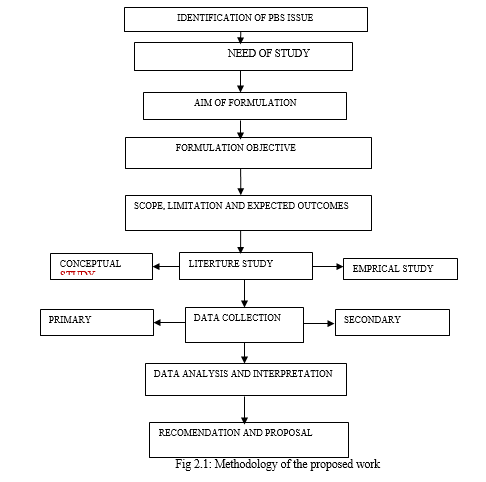
D. Safety Benefits
The safety of bicycling is a great concern for public use and loss of government property against theft and damage cause by users. It is very mush required to keep records of bicycle periodically. An automated locking and unlocking system will help in less theft and miss use of bicycles. Dedicated track or lanes are required for safe and smooth movement of users. To locate each bicycle GPS must be used. Bike sharing safety record includes the following three major categories:
(i) Safety in numbers.
(ii) Rule and regulation for users.
(iii) Bicycle's safety features.
III. CASE STUDY
A. City Profile
Bhubaneswar is primary regional hub in the state of Odisha and its capital. In the past, the area particularly the old town was often portrayed as Ekamra Khetra. Because there used to be 700 temples in this area, Bhubaneswar is known as the "Temple City". It still has a number of magnificent temples that together represent almost the whole history of Kalinga architecture, from its inception to its zenith. It displays important holy cultural landscape elements that have developed with the help of the existing natural resource base and cultural trigger owing to the wide range of heritage resources. The modern city was designed by the German architect Otto Konigsberg in 1946. Along with Jamshedpur and Chandigarh, it was one of modern India's first planned cities.
Bhubaneswar and Cuttack are often referred to as the 'twin cities of Odisha'. Bhubaneswar is categorized as a Tier-1 city and is a part of the Smart City Mission. It is an administrative, information technology, education and tourism city. Bhubaneswar was ranked as the best place to do business in India by the World Bank in 2014. Bhubaneswar has emerged as one of the fast-growing, important trading and commercial hub in the state and eastern India. With growing time Bhubaneswar has emerged as a Smart City with infrastructure, transportation and overall development. With the increase in the use of public transportation, Bhubaneswar became the first city of Odisha to introduce the public bicycle sharing (PBS) system named as MO-Cycle.
B. Location
Bhubaneswar is in the Khordha district of Odisha. It is in the eastern coastal plains, along the axis of the Eastern Ghats mountains. It is situated in latitude of 20. 296059, and longitude of 85.824539 with GPS coordinate of 20° 17' 45.8124" N and 85° 49' 28.3404" E as shown in the figure 3.1. The maximum breadth from E-W is around 14.40km, while the maximum length from N-S is 24.19km. The city has an average altitude of 45m (148ft). The city is bounded by the Daya river to the south and the Kuakhai river to the east; the Chandaka Wildlife Sanctuary and Nandankanan Zoo lie in the western and northern parts of Bhubaneswar, respectively.
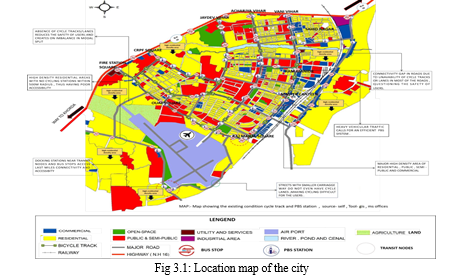
C. Geography
Topographically, Bhubaneswar has been divided into lowlands in the east and uplands in the west, with hillocks in the northern and western regions. The soil composition of Bhubaneswar is made up of 65% literate, 25% alluvial, and 10% sandstone. The UNDP reports that there is 'very high damage risk' of this region because of natural calamities. The environment of the city of Bhubaneswar has been degraded due to different human activities. The Bhubaneswar city consists of large number of residential buildings and towers, commercial complex, temples, botanical and zoological parks, The Bhubaneswar is archeologically famous for Khandagiri Udayagiri caves, Shantistup Dhauli, Bhubaneswar is renowned for its ancient temples like Lingaraj Temple, Mukteshwar Temple, and Rajarani Temple which attracting tourists from across the country.
D. Climate
Bhubaneswar experiences high temperatures and humidity during summer while the winter months are dry and mild. In the city, the months of March through mid-June are typically considered summer, with highs of up to 46.7°C. Winter only lasts for roughly ten weeks, during which the minimum temperature can drop as low as 10°C and seasonal lows can drop to 15–18°C in December to late February. 27.4 °C is the average yearly temperature, while 22–32 °C is the average monthly temperature. From June to September, the city suffers damage by rains carried in by the southwest summer monsoon via the Bay of Bengal. It gets 1,638 mm (64 in) of total annual rainfall and 404 mm (16 in) of total monthly rainfall.
E. Connectivity
As the capital of Odisha, Bhubaneswar is a prime hub and connecting route to all of the major cities within the state and most within the country. Bhubaneswar is well-connected to all other major Indian cities by airways, railways and roadways. The major transport nodes, i.e., Biju Patnaik International Airport, Master Canteen Station, Mancheswar Railway Station and Barmunda Bus Stand, fall within a 6 km radius from the city center. The major railhead linking the city with the majority of Indian cities is Bhubaneswar Railway Station. With five railway stations—Lingaraj Temple Road, Bhubaneswar Station, Mancheswar, Vani Vihar, and Patia Halt in the Bhubaneswar region—the East Coast Railway is a major transit route.
F. Demography
The Bhubaneswar Municipal Corporation spans 186 square kilometers. The BMC area's demographic information from the 2011 Census of India is displayed in the table below.
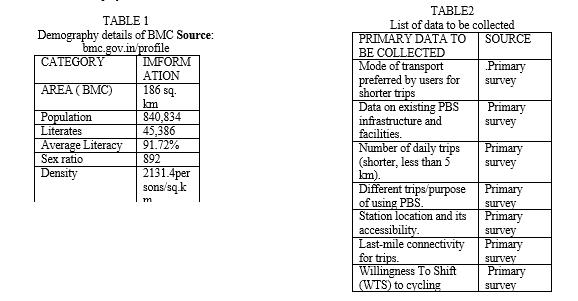
IV. DATA COLLECTION AND ANALYSIS
A. User Perception Survey
The user perception on PBS system was determined from the road side survey/interview through questionnaire with a sample size of 80 and the following analyses were determined:
(i)Modes of Transport preferred by the users
(ii)Total users of the PBS system.
(iii)Distribution and condition of cycles.
(iv) Distance covered with PBS system (MO-CYCLE)
(v)Purpose of using PBS system.
(vi) Daily trips using PBS System (Mo-Cycle)
B. Mode Of Transport Preferred By Users
Only 14% of people globally rely on cycling as their primary form of transportation for shorter distances, according to the report, while the bulk of people (25%) utilize public transportation. A bit more than 51 percent of people drive cars and two-wheelers that are privately owned. To encourage people to use active transportation, it is necessary to improve the PBS network that is now in place. Only 14% of people globally rely on cycling as their primary form of transportation for shorter distances, according to the report, while the bulk of people (25%) utilize public transportation.
A bit more than 51 percent of people drive cars and two-wheelers that are privately owned. To encourage people to use active transportation, it is necessary to improve the PBS network that is now in place. Figure 4.1 and 4.2 discuss about the preference of modes of transport and users of PBS.
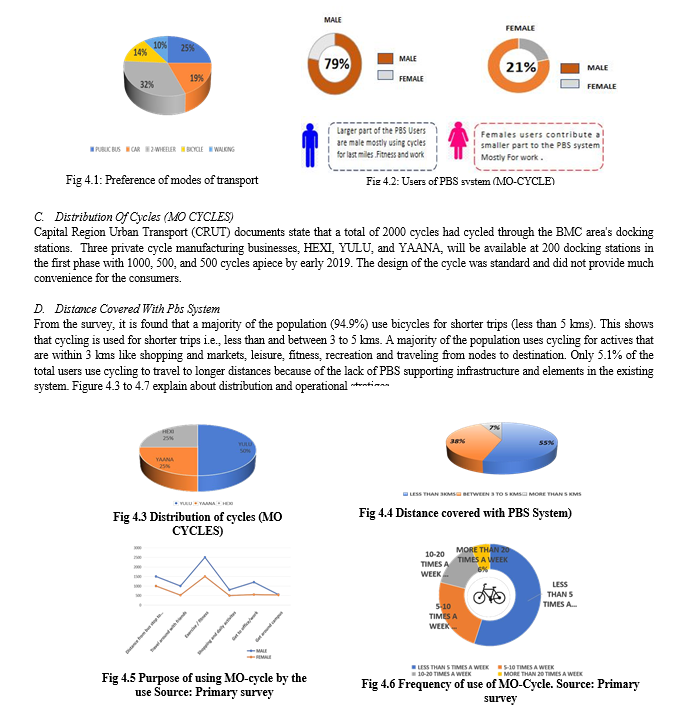
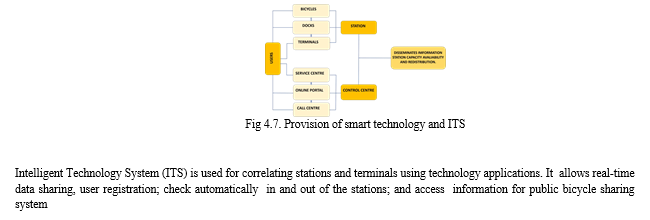
Conclusion
Public bicycle sharing system improves participants\' health, reduce pollution, and ease traffic congestion, among other advantages. The increasing demand for sustainability (from an economic, environmental, and social standpoint) pushes cities to embrace cycling as a highly advantageous option. The initial \"Mo Cycle\" Public Bicycle Share (PBS) program in Odisha was introduced as a sustainable and alternative mode of transportation. However, the program was not very successful, so this report tries to shed light on both the benefits and drawbacks of PBS. The weak points serve as a model for what needs to be changed or enhanced in order for PBS to succeed and meet the population\'s goals. The positive results increases if it provides last mile connectivity by connecting the public transport and public bicycles which offers a complete and comfortable transport chain for the acceptance of cycling as a mode of daily transport. Furthermore, PBS is closely connected with the improvement in the quality of life through better accessibility and last mile connectivity within the covering area. Another benefit of priority that was highlighted and an additional quality of life aspect are health effects of cycling and improving a city\'s image as a \'green\' or innovative city. This report makes use of a questionnaire to gather information about the characteristics of the users, changes in their behavior, and their perceptions of the scheme. It then analyzes the limitations of the scheme and seeks to resolve issues that affect not only PBS\'s future direction but also the public\'s vital interests. In order to maintain the positive effects of PBS and prevent its negative effects, it is therefore common practice to highlight the involvement of the public, private sector, and government in multi-party cooperation and the development of collaborative governance networks. Other initiatives include enhancing bicycle infrastructure, building a dense network of docking stations, bolstering law enforcement and supervision of unlawful activity, and enacting new rules and regulations. The purpose of all these suggestions is to make this plan a fantastic one.
References
[1] Brunner H., Hirz M., Hirshberg W., Fallast K., 2018, Evaluation of various means of transport for urban areas. Energy, Sustainability and Society. [2] Choudhary Ashish, Dogne Nitesh, Bharadwaj Yogesh, 2016, Infrastructural Needs and Swot Analysis of Public Bicycle Sharing System as Free Transportation in India. [3] Chrysanthou Andreas, June 2009, Best Practices in Bike Sharing Systems. [4] Dandan Xu, Yang Bian and Shian Shu, 2020, Psychological Model of Docking and Dockless Bicycle-Sharing Using Behavior. [5] De Maio P., 2009, Bike-sharing: History, Impacts, Models of Provision, and Future. Journal of Public Transportation, Volume 12(4). [6] Den Van Pascal, 2017, Velocitta\'s Better Use of Bicycle Share System (BSS), Velocitta. [7] Detailed Project Report on Public Bicycle Sharing System in Panaji . [8] Dhinu Priya, Ambika, Madhan, 2019, Planning of Bicycle Sharing System for Erode City. [9] European Conference, 2017, Local Accessibility of Hybrid Urban Public Transportation. [10] Feige Kevin, 2013, Improving the Public Bicycle Sharing System and Studying Its Impact on The City: A Case Study Of New York, United States. [11] Fishman E., 2015. Bikeshare: A Review of Recent Literature. [12] Hasan Samiul, 2018, Innovative Bike-Sharing in China: Solving Faulty Bike-Sharing [13] Recycling (FBSR). [14] ITDP India, 2017, Public Bicycle Sharing System for Delhi. [15] ITDP India, 2017, Public Bicycle Sharing System for Vadodara, Uttar Pradesh. [16] ITDP Conference, February 2020, A Survey on Smart Cycling in Goa, Conference paper. [17] Journal of the Eastern Asia Society for Transportation Studies, Vol 11, 2015 on PBS in Asian Cities. [18] Lei Wang, Chanying Li, Michael Z, Q Chen, Qing Guo Wang and Fei Tao, 2018, Connectivity Based Accessibility for Public Bicycle Sharing Systems. [19] Lwo Win Xang, 2008, Bicycle Sharing System Ensuring First/Last Mile Connectivity: A Case Study of Beijing, China. [20] Midgley Peter, 2011, Bicycle Sharing Schemes: Enhancing Sustainable Mobility in Urban Areas.
Copyright
Copyright © 2024 Subha Swostik, Swapna Sarita Swain, Piyush Ranjan Rout. This is an open access article distributed under the Creative Commons Attribution License, which permits unrestricted use, distribution, and reproduction in any medium, provided the original work is properly cited.

Download Paper
Paper Id : IJRASET62652
Publish Date : 2024-05-24
ISSN : 2321-9653
Publisher Name : IJRASET
DOI Link : Click Here
 Submit Paper Online
Submit Paper Online

